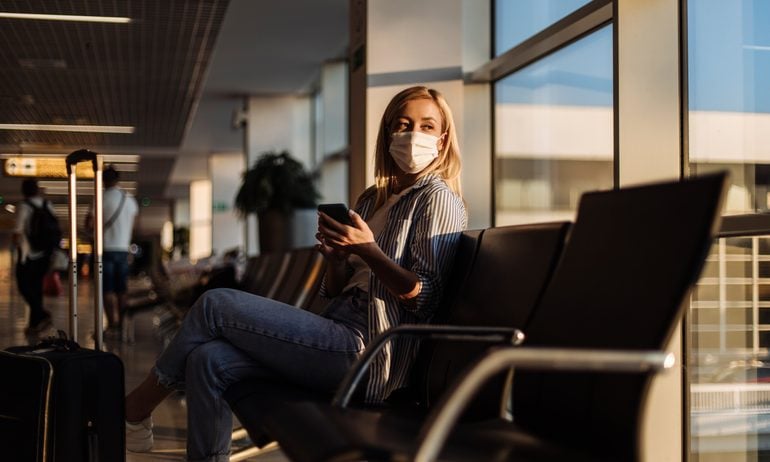How Will Relaxed COVID Guidelines Affect Your Next Trip?
Reduced isolation periods and other changes to CDC recommendations make it less likely your trip will be disrupted.

Many or all of the products on this page are from partners who compensate us when you click to or take an action on their website, but this does not influence our evaluations or ratings. Our opinions are our own.
About two and a half years into the pandemic, you might be wearing masks less often and traveling more often than you did last year. Most countries have lifted the restrictions that prevented international travel.
In an August brief, the Centers for Disease Control and Prevention said the pandemic has moved into “a different phase,” pointing to lower disease severity. The CDC also released newly relaxed guidelines that may have a big impact on how people think about the health risks related to travel.
“There is generally less risk of severe illness as a result of COVID-19 due to the resources we have available to reduce symptoms, like vaccinations, medications, and boosters,” says Dr. Janice Johnston, chief medical officer and co-founder of Redirect Health, a healthcare solutions platform.
So does that mean you can go back to traveling like you used to, with no worries about COVID-19? Only you can assess your risk tolerance, and it likely depends on your pre-existing conditions and the nature of your trip.
What the CDC guidelines say now
The CDC updated its guidelines regarding COVID-19 in August. Among the biggest changes:
Eliminating quarantining after exposure: The CDC no longer recommends that you quarantine if you’ve been exposed to someone who tests positive for COVID-19, even if you’re unvaccinated.
Reducing isolation periods: If you test positive, the CDC says it’s safe for you to end isolation after five days (even if you still test positive), as long as you’ve been fever-free for at least 24 hours and symptoms are improving. Mask-wearing is still recommended through day 10.
Reduced isolation periods — as well as the end of quarantine recommendations for people who have been exposed to COVID-19 — make it less likely that you’d have to cancel a planned trip just because your coworker got sick the day before your departure.
It also cuts back on the likelihood that you’ll have to cancel a trip if you catch COVID–19 a couple of weeks before you leave.
How to think about international travel
In June, the CDC rescinded the requirement for travelers to show a negative COVID-19 test or documentation of recovery from COVID-19 to board any U.S-bound aircraft from a foreign country.
That said, all non-immigrant, non-U.S. citizen air travelers are still required to be fully vaccinated — with proof — prior to boarding an airplane to the U.S.
Sure, there is still some risk of being exposed to COVID-19 abroad. But if you do test positive in a foreign country, the reduction of the 10-day isolation period to five also cuts down on the extra time you may need to spend in isolation abroad.
While you shouldn’t jump on an airplane if you have symptoms or know you're positive, you don't have to take a COVID test simply to board. Previous testing requirements were complicated and expensive. Some travelers reported paying $1,000 for COVID-19 tests so their families could travel internationally. Travelers who tested positive while abroad documented the stress of finding lodging and rebooking flights last minute.
Accept that anything can change — and have a plan if it does
If the past couple of years taught us anything, it’s that flexibility is king. Some cities have encouraged people to mask up again. Borders have reopened, but they could close again if another pandemic necessitated it. The state of the COVID-19 pandemic today might be different by the time your trip rolls around — and rules and recommendations might be different too.
Given the ongoing uncertainty of travel, it can be wise to purchase travel insurance. Policies typically cover illness and injury, so if you test positive for COVID-19 and can no longer travel (or need to extend a trip you’re already on to isolate), your insurer can cover those costs. And you might not even need to pay for travel insurance. Many premium travel credit cards include trip insurance as a benefit for trips paid for on that card.
And while you can take steps to mitigate personal risk, travel still may not be for everyone.
“People should not be afraid to return to pre-pandemic travel practices, though masks can always be worn in crowded spaces, and those who are significantly immunocompromised should consult with their physicians before travel,” says Dr. Joseph Kerby Gray, an emergency medicine resident in Chattanooga, Tennessee. “The vast majority of people are safe to travel as they were during pre-pandemic times, especially if they are vaccinated.”
How to maximize your rewards
You want a travel credit card that prioritizes what’s important to you. Here are some of the best travel credit cards of 2024:
Flexibility, point transfers and a large bonus: Chase Sapphire Preferred® Card
No annual fee: Wells Fargo Autograph® Card
Flat-rate travel rewards: Capital One Venture Rewards Credit Card
Bonus travel rewards and high-end perks: Chase Sapphire Reserve®
Luxury perks: The Platinum Card® from American Express
Business travelers: Ink Business Preferred® Credit Card
Chase Sapphire Preferred® Card
Travel
Dining
🔥 Huge highest-ever bonus on NerdWallet's 2025 Best All-Purpose Travel Rewards Card is back. Don't miss your rare chance to: Earn 100,000 points when you spend $5,000 on purchases in the first three months. That's worth at least $1,250 toward travel booked through Chase.


